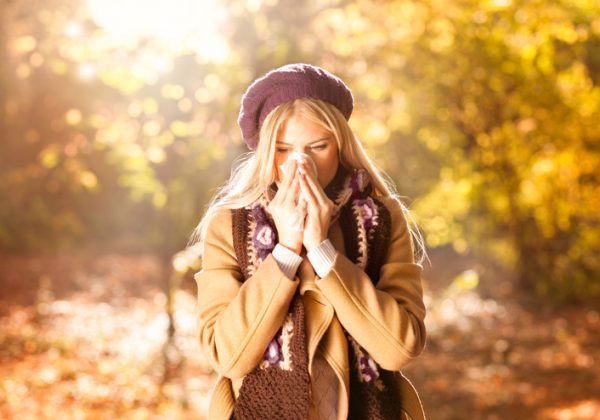
While many people tend to think of spring as peak allergy season, the reality is that millions of people suffer from allergies all year long.
According to the Asthma and Allergy Foundation of America (AAFA), allergies are one of the most common chronic diseases, with more than 100 million Americans suffering from various types of allergies each year.
Airborne allergens can cause both seasonal allergies and constant, persistent allergies. Many people with allergies have more than one type, with the most common allergy triggers being tree, grass, and weed pollen; mold spores; dust mites; and pet dander.
In 2021, according to the AAFA, approximately 81 million people in the U.S. were diagnosed with seasonal allergic rhinitis, which is commonly called ‘hay fever.’ That’s around 26% (67 million) of adults and 19% (14 million) of children! Seasonal allergic rhinitis is an allergic reaction to pollen from trees, grasses, and weeds. This type of rhinitis occurs mainly in the Spring and Fall when pollen is traveling in the air. Pollen thrives during warm days and cool nights (that’s why it’s common in spring and fall).
Seasonal Fall Allergies
Fall allergies are on the mind of many parents, teachers and students this time of year. Fall can be extremely bothersome for allergy sufferers. The biggest culprits of hay fever — a general term used to describe late-summer and fall allergies — are pollen and ragweed, according to AAFA.
Ragweed usually starts to release pollen in mid-August, when the days are still warm, and the nights start to get cooler, According to the American College of Allergy, Asthma, and Immunology (ACAAI). It can last well into September and October, typically continuing to wreak havoc until the first hard freeze, depending on where you live. It grows wild almost everywhere, especially on the East Coast and in the Midwest. Ragweed pollen is really light, so it spreads far and wide, and even if ragweed doesn’t grow where you live, ragweed pollen can travel for hundreds of miles in the wind!
Autumn leaves can also trigger allergic reactions for millions of people. While most homeowners find it difficult to keep up with all those pesky leaves, for allergy sufferers, raking leaves presents even greater challenges. It can agitate pollen and mold, releasing it into the air, causing allergy and asthma symptoms to spike.
Indoor Allergens
While the great outdoors is the source of most seasonal allergens (which also make their way inside on clothes, shoes, hair, and more), our homes also harbor all sorts of indoor allergens.
With simple everyday living, all sorts of unseen contaminants and air pollutants are generated, like dirt, dust, pet dander, cigarette smoke, and even chemicals.
Then there’s mold and mildew, which can lurk all around your home. If undetected or ignored, mold growth can turn into a serious health issue for everyone living under its roof.
Tips for Dealing with Allergens
While there is no cure for allergies many of the appliances you may already have around the house—namely a room air cleaner, vacuum and clothes washer—can help reduce indoor air pollutants and possibly reduce your symptoms. Following are our best tips for dealing with both outdoor and indoor allergens:
- Invest in a room air cleaner. Air cleaners can filter out harmful particulates such as tobacco smoke, dust, and pollen, making the air your family breathes cleaner and healthier.
- Wash your bed linens and pillowcases in hot water and detergent to reduce allergens; dry them in a hot dryer cycle to kill dust mites. Keep pets out of the bedroom to reduce pet dander in your bedding. Use dust mite-proof covers for pillows, comforters, duvets, mattresses, and box springs.
- Vacuum frequently. Vacuuming helps keep allergens low, but keep in mind that poor quality vacuums can put dust back into the air. Look for certified asthma- and allergy-friendly vacuums.
- Monitor pollen and mold counts. Local media weather reports often include this information during allergy seasons. Try to avoid being outside when pollen counts are highest.
- Prevent pollen from getting inside by keeping windows and doors closed. Use air conditioning in warm weather to control dust mites and reduce humidity. Change filters often.
- Take a shower, wash your hair, and change your clothes after you’ve been working or playing outdoors. Ask everyone who enters your home to leave their shoes at the door.
- Control dust mites by keeping surfaces in your home clean and uncluttered.
About Portable Air Cleaners
One of the best tools for combating indoor allergens is investing in an AHAM Verifide® portable room air cleaner. Room air cleaners that are certified through AHAM’s Certification Program have been certified and verified by an independent laboratory, assuring consumers that the product will perform according to the manufacturer’s product claims for suggested room size and the reduction of three common household particulates: tobacco smoke, dust, and pollen, commonly referred to as the Clean Air Delivery Rate (CADR). CADR has been evolving in recent years as more people have become interested in improving their indoor air quality. AHAM has developed standards that measure air cleaners’ removal of microbiological pollutants like viruses, bacteria and mold, and household chemicals.
Breathe easier. Learn the facts about clean indoor air here.




